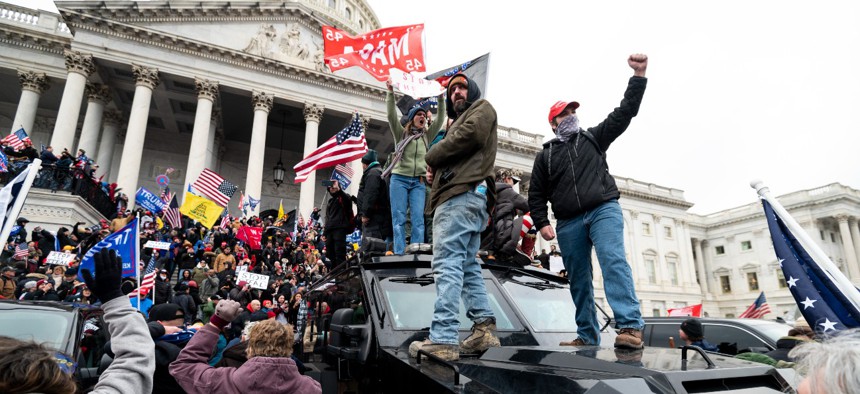
Trump supporters stand on a U.S. Capitol Police armored vehicle as others take over the steps of the Capitol on Jan. 6, 2021. Bill Clark/CQ-Roll Call, Inc via Getty Images
One Year Later: Documenting the Attack on the U.S. Capitol
The Smithsonian Institution shares its archiving efforts as the one-year anniversary of the siege of the Capitol approaches.
Ahead of the one-year anniversary of the deadly attack on the U.S. Capitol, a Smithsonian museum is sharing how it’s been documenting the event for history.
On January 6, 2021, swarms of protestors breached the Capitol as lawmakers were taking up certification of the 2020 presidential election, with then-Vice President Mike Pence presiding. Then-President Trump had refused to concede the election, which led to an unprecedentedly rocky transition of power between November and January that is normally seen as a bipartisan tradition.
“The Jan. 6 attack on the Capitol, and on the foundation of the United States’ democratic republic, revealed the fragility of our political system,” said Anthea Hartig, the National Museum of American History’s Elizabeth MacMillan director, in a press release on Monday. “As the nation’s flagship history museum, our staff is committed to documenting and, most importantly, preserving this history for future generations to understand how the events of that fraught day unfolded and to track their ongoing impacts.”
There were five deaths as a direct result of the attack and four known suicides by officers who responded that day. Trump was impeached in the House, for the second time, in early 2021 for incitement of insurrection, but was acquitted in the Senate. More than 700 people had been arrested for crimes related to the attack and 71 had been sentenced as of January 1, according to Politico’s tracker.
The day after the attack, the museum used its “rapid-response protocol” to collect posters, flags, signs and other discarded objects, said a press release from the Smithsonian Institution. “During the past year, curators from the Division of Political and Military History and the Photographic History Collection have collected additional materials that represent various aspects of the attack and its aftermath.” This includes the blue suit that Rep. Andy Kim, D-N.J., wore as he cleaned up the Capitol building after the destruction and the National Guard sleeve insignia.
“It has been challenging for the museum to collect and bring Jan. 6 artifacts into the building due to COVID-19 restrictions and because the events are the subject of an extensive investigation by the Select Committee to Investigate the January 6th Attack on the United States Capitol, as well as those by the FBI, the U.S. Capitol Police and numerous other law-enforcement agencies,” said the Smithsonian. “As the museum’s work cannot interfere with such investigations, staff continue to monitor progress and remain in touch with federal agencies and congressional offices about possible collections.”
Additionally, curators are in discussion with photojournalists and freelance photographers about obtaining their photos of the event. While the work is ongoing, there isn’t an immediate plan for a museum exhibit.
Also, on the one-year anniversary of the attacks Thursday, the museum with the University of Alabama’s Department of Religious Studies is launching a website titled “Uncivil Religion: January 6, 2021” with digital media (such as tweets, photos and FBI files) showcasing religious beliefs on display at the attack. The website will also have interpretive essays written by international religious studies scholars.
Among the other commemoration events, Attorney General Merrick Garland will give an address to Justice Department employees on Wednesday about efforts to hold those responsible for the attack accountable and uphold the Constitution, NPR and The Washington Post reported.







